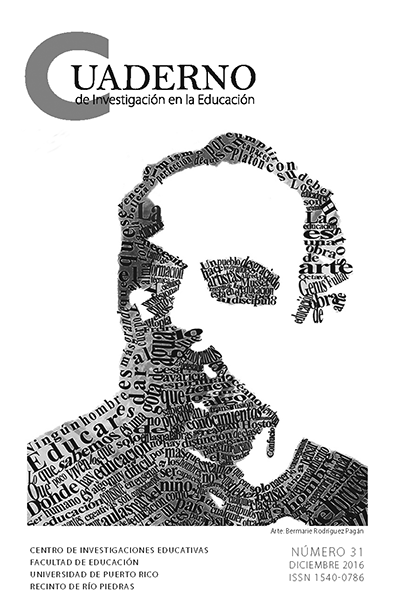Abstract
Educators worldwide confront challenges induced by sociocultural exchanges raised in pluralist contexts. One of the fundamental aspects of this article is to revise multicultural projects implemented in The United States of America and other European, African and Asian countries. They reiterate the validity of public policies based in reforms to educate "minorities" and instruct educators about ethno-cultural policies. On the other hand, the findings of studies in various nations reveal teachers ignore theories, models and strategies with a multicultural approach. Specifically, this paper focuses on the potential of art teachers in the development of cultural citizens. Therefore, we suggest some courses and innovative programs that have been successful as part of teaching education programs of Fine Arts. Also, we identify multicultural approaches that could be considered in the elaboration of Puerto Rico‘s art curriculum.
How to cite:
Lara-Fonseca, L. (2016). El maestro de arte ante los retos de contextos pluralistas: Política pública, el currículo y los programas de preparación de maestros a nivel local e internacional. Cuaderno de Investihación en la Educación, 31, 11-31. Retrieved from https://revistas.upr.edu/index.php/educacion/article/view/13100
References
Banks, J. (2007). Educating citizens in a multicultural society (2da ed.). Nueva York, NY: Teachers College Press.
Banks, J. (2004). Diversity and citizenship education: Global perspectives. San Francisco, CA: Jossey-Bass.
Chalmers, G. (1996). Celebrating pluralism: Art, education, and cultural diversity. Los Ángeles, CA: The J. Paul Getty Trust.
Chang, I. (2011). Multicultural education in Korea: Its origin, status and direction. Multicultural Education Review, 4(2), 60-90. Recuperado de http://www.tandfonline.com/doi/abs/10.1080/2005615X.2011.11102894
Chin C. (2013). Key dimensions of a multicultural art education curriculum. International Journal of Education & the Arts, 14(14). Recuperado de http://www.ijea.org/v14n14
Chung, M. & Miller, J. (2011, verano). Do we live in a box of crayons? Looking at multicultural metaphors written by teachers. Research Multicultural Education, 18(4), 39-45. Recuperado de http://eric.ed.gov/?id=EJ963748
Day, M. (1993). Cultural diversity and discipline-based art education. En Getty Center for Education in the Arts, Seminar Proceedings: Discipline-based art education and cultural diversity (pp. 23-25). Austin, Texas: The Getty Center for Education in the Arts.
Departamento de Educación. (2000). Estándares de Excelencia: Programa de Bellas Artes. Hato Rey, PR: Autor.
Departamento de Educación, Instituto Nacional para el Desarrollo Curricular. (2003). Marco Curricular del Programa de Bellas Artes. Hato Rey, P.R.: Autor.
Departamento de Educación. (2007). Estándares y expectativas del Programa de Bellas Artes. Hato Rey, Puerto Rico: Autor.
Departamento de Educación. (2013, 20 de julio). Carta Circular Núm. 5- 2013-2014. San Juan, PR. Autor.
Dervin, F., Paatela-Nieminen, M., Kuoppala, K. & Riitaoja, A. L. (2012). Multicultural education in Finland: Renewed intercultural competencies to the rescue? International Journal of Multicultural Education. 14(3), pp. 1-10. Recuperado de http://ijme-journal.org/index.php/ijme/article/view/564
Galbraith, L. (1997). What are art teachers taught? An analysis of curriculum components for art teacher preparation programs. En M. Day (Ed.), Preparing teachers of art (pp. 45-72). Reston, VA: National Art Education Association.
Kraehe, A. (2010). Multicultural art education in an era of standardized testing: Changes in knowledge and skill for art teacher certification in Texas. Studies in Art Education: A Journal of Issues and Research, 51(2), 162-175. Recuperado de http://www.tandfonline.com/doi/abs/10.1080/00393541.2010.11518799
Kuttner, P. (2015). Educating for cultural citizenship: Reframing the goals of art education Curriculum Inquiry, 45(1), 69-92. Recuperado de http://dx.doi.org/10.1080/03626784.980940
Lee, N. (2013). Engaging the pink elephant in the room: Investigating race and racism through art education (Disertación doctoral inédita). University of Georgia, Tennessee.
Margo, R. (2014). Representation of the Ethiopian multicultural society in secondary teacher education curricula. Journal of Teacher Education for Sustainability,16(1), 54-75.
McLean, K. (1996). Through students eyes: Combating racism in United States Schools. Connecticut: Praeger.
Organización de las Naciones Unidas para la Educación, la Ciencia y la Cultura. (2006). Hoja de ruta para la educación artística. Conferencia Mundial sobre la Educación Artística: Construir Capacidades Creativas para el Siglo XXI, Lisboa, Portugal, del 6 al 9 de marzo de 2006.
Population Reference Bureau. (2011). World Population Data Sheet 2011. Washington, D.C.: Autor. Recuperado de http://www.prb.org/pdf11/2011population-data-sheet_eng.pdf
Rodríguez-Velez, T. (2013). Developing a multicultural theatre undergraduate program for the Commonwealth of Puerto Rico: A professional problem dissertation. (Disertación doctoral). Texas Tech University. Recuperado de http://repositories.tdl.org/ttuir/handle/2346/50721
Surillo, F. (1992). Percepción de los profesionales de la Educación sobre la incorporación formal y sistemática de las Bellas Artes en el currículo del nivel elemental (Disertación doctoral inédita). Universidad Interamericana de Puerto Rico, Recinto Metropolitano, San Juan, Puerto Rico.
Teshome, Y & Hassan, T. (2014). The role of multicultural art education in a cultural diversified society: The case of Tigray College of Arts. (Tesis de maestría). University of Gothenburg, Suecia. Recuperado de https://gupea.ub.gu.se/bitstream/2077/38262/1/gupea_2077_38262_1.pdf
U.S. Census Bureau. (2011). 2010 Census Data. Washington, D.C.: Autor. Recuperado de http://www.census.gov/2010census/data/
U.S. Census Bureau. (2014). 2009-2013 5 –Year American Community Survey. Washington, D.C.: Autor. Recuperado de http://www.census.gov/data/developers/data-sets.html
U.S. Department of Education. (2007). Final Guidance on Maintaining, Collecting, and Reporting Racial and Ethnic Data to the US Department of Education. Federal Register, 72,(202), 59266-59279.
Vale, E. ( 2001). Percepción de los maestros en torno a su nivel de competencia en los Estándares de Contenido de Artes Visuales y su preferencia para la educación en servicio (Tesis de maestría inédita). Universidad de Puerto Rico, Recinto de Río Piedras.
Vivoni-Alcaraz, P. (1985). Teaching goals among art faculty in Puerto Rico (Doctoral Dissertation in Education). Illinois State University, Illinois.
Wickham, A. (2014). Culturally responsive art educators: Proactive training for pre-service teachers (Tesis de maestría inédita). University of Akron, Ohio.
Yakunchev, M. A. & Gorshenina, S. N. (2013). Diagnostics of Ethno-Cultural Competence of the Future Taechers. Middle-East Journal of Scientific Research, 16(12), 1709-1713.
The contents published in the Puerto Rico Journal of Education is freely distributed under open access practices, in accordance with the Creative Commons license, Attribution-NonCommercial 4.0 International (CC BY-NC 4.0). Through these principles, the journal and its authors allow readers to access, reproduce and share articles in full text. Users should give credit to authors in a reasonable way without suggesting they have their support. Under no circumstances, readers may make use of the contents for commercial purposes. The authors retain copyright on their works.

